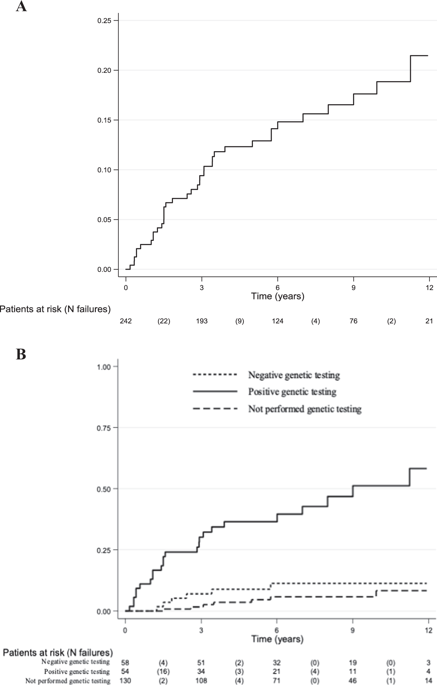当前位置:
X-MOL 学术
›
Hypertens. Res.
›
论文详情
Our official English website, www.x-mol.net, welcomes your
feedback! (Note: you will need to create a separate account there.)
Predictors of recurrence of pheochromocytoma and paraganglioma: a multicenter study in Piedmont, Italy
Hypertension Research ( IF 4.3 ) Pub Date : 2019-10-04 , DOI: 10.1038/s41440-019-0339-y Mirko Parasiliti-Caprino 1 , Barbara Lucatello 1 , Chiara Lopez 1 , Jacopo Burrello 2 , Francesca Maletta 3 , Marinella Mistrangelo 4 , Enrica Migliore 5 , Francesco Tassone 6 , Antonio La Grotta 7 , Anna Pia 8 , Giuseppe Reimondo 8 , Roberta Giordano 9 , Giuseppe Giraudo 10 , Alessandro Piovesan 11 , Giovannino Ciccone 5 , Dèsirèe Deandreis 12 , Paolo Limone 13 , Fabio Orlandi 14 , Giorgio Borretta 6 , Marco Volante 15 , Paolo Mulatero 2 , Mauro Papotti 3 , Gianluca Aimaretti 16 , Massimo Terzolo 8 , Mario Morino 10 , Barbara Pasini 17 , Franco Veglio 2 , Ezio Ghigo 1 , Emanuela Arvat 11 , Mauro Maccario 1
Hypertension Research ( IF 4.3 ) Pub Date : 2019-10-04 , DOI: 10.1038/s41440-019-0339-y Mirko Parasiliti-Caprino 1 , Barbara Lucatello 1 , Chiara Lopez 1 , Jacopo Burrello 2 , Francesca Maletta 3 , Marinella Mistrangelo 4 , Enrica Migliore 5 , Francesco Tassone 6 , Antonio La Grotta 7 , Anna Pia 8 , Giuseppe Reimondo 8 , Roberta Giordano 9 , Giuseppe Giraudo 10 , Alessandro Piovesan 11 , Giovannino Ciccone 5 , Dèsirèe Deandreis 12 , Paolo Limone 13 , Fabio Orlandi 14 , Giorgio Borretta 6 , Marco Volante 15 , Paolo Mulatero 2 , Mauro Papotti 3 , Gianluca Aimaretti 16 , Massimo Terzolo 8 , Mario Morino 10 , Barbara Pasini 17 , Franco Veglio 2 , Ezio Ghigo 1 , Emanuela Arvat 11 , Mauro Maccario 1
Affiliation

|
The available data on the natural history of pheochromocytomas and paragangliomas after radical surgery are heterogeneous and discordant. The aim of our retrospective multicenter study was to find predictors of recurrence in patients with pheochromocytomas and sympathetic paragangliomas submitted to radical surgery in Piedmont (a region in northwest Italy). We collected data from 242 patients diagnosed between 1990 and 2016. Forty-two patients (17.4%) had disease recurrence. Multivariate analysis showed that genetic mutation (HR = 3.62; 95% CI 1.44−9.13; p = 0.006), younger age (HR = 0.97; 95% CI 0.95−0.99; p = 0.031) and larger tumor size (HR = 1.01; 95% CI 1.00−1.02; p = 0.015) were independently associated with a higher recurrence risk of pheochromocytoma and paraganglioma; in pheochromocytomas, genetic mutation (HR = 3.4; 95% CI 1.00−11.48; p = 0.049), younger age (HR = 0.97; 95% CI 0.94−0.99; p = 0.02), higher tumor size (HR = 1.01; 95% CI 1.00−1.03; p = 0.043) and PASS value (HR = 1.16; 95% CI 1.03−1.3; p = 0.011) were associated with recurrence. Moreover, tumor size was the only predictor of metastatic pheochromocytoma and paraganglioma (HR = 4.6; 95% CI 1.4−15.0; p = 0.012); tumor size (HR = 3.93; 95% CI 1.2−16.4; p = 0.026) and PASS value (HR = 1.27; 95% CI 1.06−1.53; p = 0.007) were predictors of metastatic pheochromocytoma. In conclusion, our findings suggest that the recurrence of pheochromocytoma and sympathetic paraganglioma develops more frequently in younger subjects, patients with a family history of chromaffin tissue neoplasms, mutations in susceptibility genes, larger tumors and higher values of PASS. We recommend genetic testing in all patients with PPGL and strict follow-up at least on an annual basis.
中文翻译:

嗜铬细胞瘤和副神经节瘤复发的预测因素:意大利皮埃蒙特的一项多中心研究
关于根治性手术后嗜铬细胞瘤和副神经节瘤自然病程的现有数据是异质和不一致的。我们回顾性多中心研究的目的是寻找皮埃蒙特(意大利西北部地区)接受根治性手术的嗜铬细胞瘤和交感神经副神经节瘤患者复发的预测因素。我们收集了 1990 年至 2016 年间诊断出的 242 名患者的数据。 42 名患者 (17.4%) 出现疾病复发。多变量分析显示基因突变(HR = 3.62;95% CI 1.44−9.13;p = 0.006)、年龄较小(HR = 0.97;95% CI 0.95−0.99;p = 0.031)和较大的肿瘤大小(HR = 1.01; 95% CI 1.00−1.02;p = 0.015) 与较高的嗜铬细胞瘤和副神经节瘤复发风险独立相关;在嗜铬细胞瘤中,基因突变(HR = 3.4;95% CI 1.00-11.48;p = 0.049)、年龄较小(HR = 0.97;95% CI 0.94−0.99;p = 0.02)、较大的肿瘤大小(HR = 1.01;95% CI 1.00−1.03;p = 0.043)和 PASS 值(HR = 1.16) ;95% CI 1.03-1.3;p = 0.011) 与复发相关。此外,肿瘤大小是转移性嗜铬细胞瘤和副神经节瘤的唯一预测因子(HR = 4.6;95% CI 1.4-15.0;p = 0.012);肿瘤大小(HR = 3.93;95% CI 1.2-16.4;p = 0.026)和 PASS 值(HR = 1.27;95% CI 1.06-1.53;p = 0.007)是转移性嗜铬细胞瘤的预测因子。总之,我们的研究结果表明,嗜铬细胞瘤和交感神经副神经节瘤的复发在年轻受试者、有嗜铬组织肿瘤家族史、易感基因突变、肿瘤较大和 PASS 值较高的患者中发生得更频繁。
更新日期:2019-10-04
中文翻译:

嗜铬细胞瘤和副神经节瘤复发的预测因素:意大利皮埃蒙特的一项多中心研究
关于根治性手术后嗜铬细胞瘤和副神经节瘤自然病程的现有数据是异质和不一致的。我们回顾性多中心研究的目的是寻找皮埃蒙特(意大利西北部地区)接受根治性手术的嗜铬细胞瘤和交感神经副神经节瘤患者复发的预测因素。我们收集了 1990 年至 2016 年间诊断出的 242 名患者的数据。 42 名患者 (17.4%) 出现疾病复发。多变量分析显示基因突变(HR = 3.62;95% CI 1.44−9.13;p = 0.006)、年龄较小(HR = 0.97;95% CI 0.95−0.99;p = 0.031)和较大的肿瘤大小(HR = 1.01; 95% CI 1.00−1.02;p = 0.015) 与较高的嗜铬细胞瘤和副神经节瘤复发风险独立相关;在嗜铬细胞瘤中,基因突变(HR = 3.4;95% CI 1.00-11.48;p = 0.049)、年龄较小(HR = 0.97;95% CI 0.94−0.99;p = 0.02)、较大的肿瘤大小(HR = 1.01;95% CI 1.00−1.03;p = 0.043)和 PASS 值(HR = 1.16) ;95% CI 1.03-1.3;p = 0.011) 与复发相关。此外,肿瘤大小是转移性嗜铬细胞瘤和副神经节瘤的唯一预测因子(HR = 4.6;95% CI 1.4-15.0;p = 0.012);肿瘤大小(HR = 3.93;95% CI 1.2-16.4;p = 0.026)和 PASS 值(HR = 1.27;95% CI 1.06-1.53;p = 0.007)是转移性嗜铬细胞瘤的预测因子。总之,我们的研究结果表明,嗜铬细胞瘤和交感神经副神经节瘤的复发在年轻受试者、有嗜铬组织肿瘤家族史、易感基因突变、肿瘤较大和 PASS 值较高的患者中发生得更频繁。









































 京公网安备 11010802027423号
京公网安备 11010802027423号